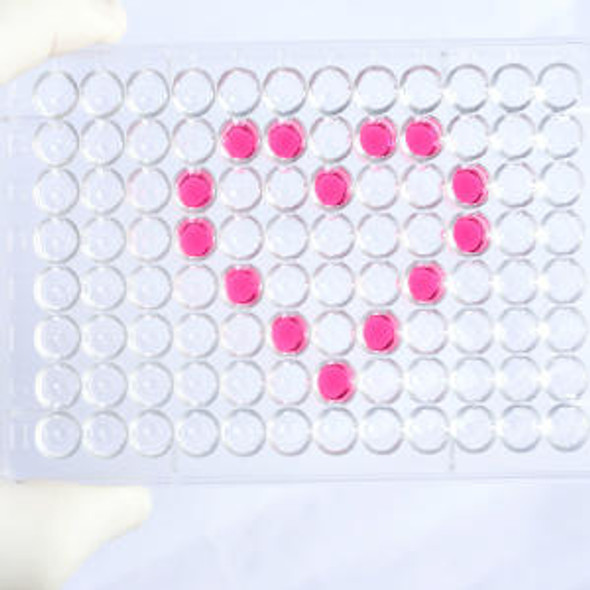Human Insulin-like growth factor I (IGF1) ELISA Kit
- SKU:
- HUEB0012
- Product Type:
- ELISA Kit
- Size:
- 96 Assays
- Uniprot:
- P05019
- Range:
- 78-5000 pg/mL
- ELISA Type:
- Sandwich
- Synonyms:
- IGF-1, IGF1, IGFI, IGF-I, IGF1A, IGF-IA, IGF-IB, MGF, Somatomedin C
- Reactivity:
- Human
Description
| Product Name: | Human Insulin-like growth factor I (IGF1) ELISA Kit |
| Product Code: | HUEB0012 |
| Alias: | Insulin-like growth factor I, IGF-I, Mechano growth factor, MGF, Somatomedin-C, IGF1, IBP1 |
| Uniprot: | P05019 |
| Reactivity: | Human |
| Range: | 78-5000 pg/mL |
| Detection Method: | Sandwich |
| Size: | 96 Assay |
| Storage: | Please see kit components below for exact storage details |
| Note: | For research use only |
| UniProt Protein Function: | IGF1: The insulin-like growth factors, isolated from plasma, are structurally and functionally related to insulin but have a much higher growth-promoting activity. May be a physiological regulator of [1-14C]-2-deoxy-D-glucose (2DG) transport and glycogen synthesis in osteoblasts. Stimulates glucose transport in rat bone-derived osteoblastic (PyMS) cells and is effective at much lower concentrations than insulin, not only regarding glycogen and DNA synthesis but also with regard to enhancing glucose uptake. Defects in IGF1 are the cause of insulin-like growth factor I deficiency (IGF1 deficiency). IGF1 deficiency is an autosomal recessive disorder characterized by growth retardation, sensorineural deafness and mental retardation. Belongs to the insulin family. 3 isoforms of the human protein are produced by alternative splicing. |
| UniProt Protein Details: | Protein type:Secreted; Secreted, signal peptide; Motility/polarity/chemotaxis Chromosomal Location of Human Ortholog: 12q23.2 Cellular Component: insulin-like growth factor binding protein complex; extracellular space; plasma membrane; extracellular region Molecular Function:integrin binding; insulin-like growth factor receptor binding; protein binding; growth factor activity; hormone activity; insulin receptor binding Biological Process: muscle development; positive regulation of transcription, DNA-dependent; chondroitin sulfate proteoglycan biosynthetic process; exocrine pancreas development; glycolate metabolic process; water homeostasis; positive regulation of glucose import; positive regulation of fibroblast proliferation; proteoglycan biosynthetic process; inner ear development; positive regulation of DNA binding; muscle hypertrophy; platelet activation; positive regulation of protein import into nucleus, translocation; positive regulation of mitosis; regulation of establishment and/or maintenance of cell polarity; positive regulation of phosphoinositide 3-kinase cascade; cell activation; positive regulation of peptidyl-tyrosine phosphorylation; branching morphogenesis of a tube; insulin-like growth factor receptor signaling pathway; response to heat; regulation of gene expression; positive regulation of transcription from RNA polymerase II promoter; alveolus development; positive regulation of epithelial cell proliferation; negative regulation of apoptosis; positive regulation of insulin-like growth factor receptor signaling pathway; myoblast proliferation; positive regulation of smooth muscle cell proliferation; positive regulation of glycogen biosynthetic process; positive regulation of activated T cell proliferation; signal transduction; positive regulation of smooth muscle cell migration; negative regulation of cell proliferation; platelet degranulation; glial cell differentiation; positive regulation of MAPKKK cascade; mammary gland development; positive regulation of cell proliferation; DNA replication; skeletal development; positive regulation of granule cell precursor proliferation; phosphoinositide-mediated signaling; multicellular organism growth; regulation of multicellular organism growth; myotube cell development; satellite cell compartment self-renewal involved in skeletal muscle regeneration; myoblast differentiation; positive regulation of osteoblast differentiation; positive regulation of protein kinase B signaling cascade; cell proliferation; cellular protein metabolic process; positive regulation of tyrosine phosphorylation of Stat5 protein; positive regulation of glycolysis; Ras protein signal transduction; blood vessel remodeling; positive regulation of Ras protein signal transduction; blood coagulation; cell motility; positive regulation of DNA replication Disease: Insulin-like Growth Factor I Deficiency |
| NCBI Summary: | The protein encoded by this gene is similar to insulin in function and structure and is a member of a family of proteins involved in mediating growth and development. The encoded protein is processed from a precursor, bound by a specific receptor, and secreted. Defects in this gene are a cause of insulin-like growth factor I deficiency. Several transcript variants encoding different isoforms have been found for this gene.[provided by RefSeq, Mar 2009] |
| UniProt Code: | P05019 |
| NCBI GenInfo Identifier: | 124263 |
| NCBI Gene ID: | 3479 |
| NCBI Accession: | P05019.1 |
| UniProt Secondary Accession: | P05019,P01343, Q14620, B2RWM7, E9PD02, |
| UniProt Related Accession: | P05019 |
| Molecular Weight: | 17,762 Da |
| NCBI Full Name: | Insulin-like growth factor I |
| NCBI Synonym Full Names: | insulin-like growth factor 1 (somatomedin C) |
| NCBI Official Symbol: | IGF1 |
| NCBI Official Synonym Symbols: | IGFI; IGF-I; IGF1A |
| NCBI Protein Information: | insulin-like growth factor I; MGF; IGF-IA; IGF-IB; somatomedin-C; mechano growth factor; insulin-like growth factor IA; insulin-like growth factor IB |
| UniProt Protein Name: | Insulin-like growth factor I |
| UniProt Synonym Protein Names: | Mechano growth factor; MGF; Somatomedin-C |
| Protein Family: | Insulin-like growth factor |
| UniProt Gene Name: | IGF1 |
| UniProt Entry Name: | IGF1_HUMAN |
| Component | Quantity (96 Assays) | Storage |
| ELISA Microplate (Dismountable) | 8×12 strips | -20°C |
| Lyophilized Standard | 2 | -20°C |
| Sample Diluent | 20ml | -20°C |
| Assay Diluent A | 10mL | -20°C |
| Assay Diluent B | 10mL | -20°C |
| Detection Reagent A | 120µL | -20°C |
| Detection Reagent B | 120µL | -20°C |
| Wash Buffer | 30mL | 4°C |
| Substrate | 10mL | 4°C |
| Stop Solution | 10mL | 4°C |
| Plate Sealer | 5 | - |
Other materials and equipment required:
- Microplate reader with 450 nm wavelength filter
- Multichannel Pipette, Pipette, microcentrifuge tubes and disposable pipette tips
- Incubator
- Deionized or distilled water
- Absorbent paper
- Buffer resevoir
*Note: The below protocol is a sample protocol. Protocols are specific to each batch/lot. For the correct instructions please follow the protocol included in your kit.
Allow all reagents to reach room temperature (Please do not dissolve the reagents at 37°C directly). All the reagents should be mixed thoroughly by gently swirling before pipetting. Avoid foaming. Keep appropriate numbers of strips for 1 experiment and remove extra strips from microtiter plate. Removed strips should be resealed and stored at -20°C until the kits expiry date. Prepare all reagents, working standards and samples as directed in the previous sections. Please predict the concentration before assaying. If values for these are not within the range of the standard curve, users must determine the optimal sample dilutions for their experiments. We recommend running all samples in duplicate.
| Step | |
| 1. | Add Sample: Add 100µL of Standard, Blank, or Sample per well. The blank well is added with Sample diluent. Solutions are added to the bottom of micro ELISA plate well, avoid inside wall touching and foaming as possible. Mix it gently. Cover the plate with sealer we provided. Incubate for 120 minutes at 37°C. |
| 2. | Remove the liquid from each well, don't wash. Add 100µL of Detection Reagent A working solution to each well. Cover with the Plate sealer. Gently tap the plate to ensure thorough mixing. Incubate for 1 hour at 37°C. Note: if Detection Reagent A appears cloudy warm to room temperature until solution is uniform. |
| 3. | Aspirate each well and wash, repeating the process three times. Wash by filling each well with Wash Buffer (approximately 400µL) (a squirt bottle, multi-channel pipette,manifold dispenser or automated washer are needed). Complete removal of liquid at each step is essential. After the last wash, completely remove remaining Wash Buffer by aspirating or decanting. Invert the plate and pat it against thick clean absorbent paper. |
| 4. | Add 100µL of Detection Reagent B working solution to each well. Cover with the Plate sealer. Incubate for 60 minutes at 37°C. |
| 5. | Repeat the wash process for five times as conducted in step 3. |
| 6. | Add 90µL of Substrate Solution to each well. Cover with a new Plate sealer and incubate for 10-20 minutes at 37°C. Protect the plate from light. The reaction time can be shortened or extended according to the actual color change, but this should not exceed more than 30 minutes. When apparent gradient appears in standard wells, user should terminatethe reaction. |
| 7. | Add 50µL of Stop Solution to each well. If color change does not appear uniform, gently tap the plate to ensure thorough mixing. |
| 8. | Determine the optical density (OD value) of each well at once, using a micro-plate reader set to 450 nm. User should open the micro-plate reader in advance, preheat the instrument, and set the testing parameters. |
| 9. | After experiment, store all reagents according to the specified storage temperature respectively until their expiry. |
When carrying out an ELISA assay it is important to prepare your samples in order to achieve the best possible results. Below we have a list of procedures for the preparation of samples for different sample types.
| Sample Type | Protocol |
| Serum | If using serum separator tubes, allow samples to clot for 30 minutes at room temperature. Centrifuge for 10 minutes at 1,000x g. Collect the serum fraction and assay promptly or aliquot and store the samples at -80°C. Avoid multiple freeze-thaw cycles. If serum separator tubes are not being used, allow samples to clot overnight at 2-8°C. Centrifuge for 10 minutes at 1,000x g. Remove serum and assay promptly or aliquot and store the samples at -80°C. Avoid multiple freeze-thaw cycles. |
| Plasma | Collect plasma using EDTA or heparin as an anticoagulant. Centrifuge samples at 4°C for 15 mins at 1000 × g within 30 mins of collection. Collect the plasma fraction and assay promptly or aliquot and store the samples at -80°C. Avoid multiple freeze-thaw cycles. Note: Over haemolysed samples are not suitable for use with this kit. |
| Urine & Cerebrospinal Fluid | Collect the urine (mid-stream) in a sterile container, centrifuge for 20 mins at 2000-3000 rpm. Remove supernatant and assay immediately. If any precipitation is detected, repeat the centrifugation step. A similar protocol can be used for cerebrospinal fluid. |
| Cell culture supernatant | Collect the cell culture media by pipette, followed by centrifugation at 4°C for 20 mins at 1500 rpm. Collect the clear supernatant and assay immediately. |
| Cell lysates | Solubilize cells in lysis buffer and allow to sit on ice for 30 minutes. Centrifuge tubes at 14,000 x g for 5 minutes to remove insoluble material. Aliquot the supernatant into a new tube and discard the remaining whole cell extract. Quantify total protein concentration using a total protein assay. Assay immediately or aliquot and store at ≤ -20 °C. |
| Tissue homogenates | The preparation of tissue homogenates will vary depending upon tissue type. Rinse tissue with 1X PBS to remove excess blood & homogenize in 20ml of 1X PBS (including protease inhibitors) and store overnight at ≤ -20°C. Two freeze-thaw cycles are required to break the cell membranes. To further disrupt the cell membranes you can sonicate the samples. Centrifuge homogenates for 5 mins at 5000xg. Remove the supernatant and assay immediately or aliquot and store at -20°C or -80°C. |
| Tissue lysates | Rinse tissue with PBS, cut into 1-2 mm pieces, and homogenize with a tissue homogenizer in PBS. Add an equal volume of RIPA buffer containing protease inhibitors and lyse tissues at room temperature for 30 minutes with gentle agitation. Centrifuge to remove debris. Quantify total protein concentration using a total protein assay. Assay immediately or aliquot and store at ≤ -20 °C. |
| Breast Milk | Collect milk samples and centrifuge at 10,000 x g for 60 min at 4°C. Aliquot the supernatant and assay. For long term use, store samples at -80°C. Minimize freeze/thaw cycles. |










